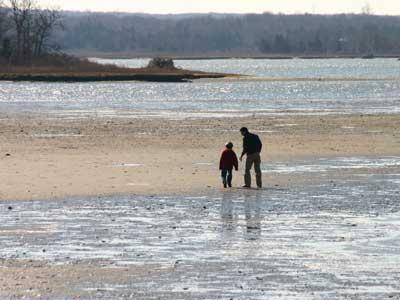Shellfish Closures Rankle Trustees

As the East Hampton Town Trustees prepare to convene with two newly elected members on Jan. 14, the board’s incumbents continue to be frustrated by the State Department of Environmental Conservation’s procedures for water-quality assessment.
In November, the D.E.C. reclassified approximately 15 acres of Hand’s Creek in East Hampton, closing it to shellfish harvesting year-round instead of its previous seasonally uncertified classification. And approximately 14 acres of Accabonac Harbor were reclassified as seasonally uncertified, and are now closed to shellfishing from May 1 through Nov. 30.
The reclassifications were part of emergency regulations the D.E.C. announced that affected 3,690 acres of Long Island waters. Agency officials said the action resulted from its analyses demonstrating increased levels of fecal coliform bacteria and the potential for shellfish harvested from the areas in question to cause illness if consumed.
The D.E.C., said Lori Severino, a spokeswoman, adheres to the National Shellfish Sanitation Program’s minimum sampling requirements for certifying shellfish lands. Areas that are certified, or open for shellfishing, must be sampled at least six times per year. “This sampling is conducted throughout the entire year in order to get a good representation of water quality,” she said. “Seasonally certified areas must be sampled at least once per month during the period they are open for harvesting.”
The department, she said, “does meet or exceed these sampling requirements. In the Three Mile and Accabonac evaluations, D.E.C.’s water quality testing exceeded the required sampling frequency.”
The trustees, who oversee the town’s beaches, waterways, and bottomlands on the behalf of the public, take exception to the D.E.C.’s conclusions. Following the department’s reclassifications of the water bodies in question, Diane McNally, the trustees’ clerk, or presiding officer, said that the D.E.C.’s Bureau of Marine Resources was understaffed and questioned the timeliness of its water-quality data. The D.E.C.’s reclassifications, she suggested, were based more on projections than accurate and up-to-date information.
Stephanie Talmage Forsberg, a trustee who holds a doctoral degree in marine biology, also questioned the D.E.C.’s conclusions, saying that the reclassifications “do not necessarily reflect the water quality of these systems as a whole.”
Ms. Severino took exception to the trustees’ skepticism. “The decisions to downgrade the affected areas in the Town of East Hampton were based on the evaluation of fecal coliform data, which were conducted in conformance with the requirements of [the state] and the N.S.S.P.,” she said. “The areas that have been designated as uncertified demonstrated elevated fecal coliform levels and failed to meet criteria for certified shellfish lands. These areas are re quired to be closed for the harvest of shellfish.”
Ms. McNally remains skeptical. “If they can only get people out here on certain days after a certain amount of rain . . . they can’t get accurate data,” she said last month.
In the fall, Michael Bye, a bayman who was hired by the trustees in August to operate a pumpout boat, received training in water-quality sampling from the D.E.C. The trustees hoped that Mr. Bye’s assistance would augment the D.E.C.’s testing and provide a more accurate assessment of shellfish beds under their jurisdiction.
The D.E.C. has authorized Mr. Bye to collect water samples to support the evaluation of conditional harvest programs in Accabonac Harbor and Northwest Creek, Ms. Severino said. “When conditions are appropriate, following targeted rainfall events, Mr. Bye has been approved by D.E.C. to collect water samples in these shellfish growing areas,” she said. But, she added, “The purpose of his assistance will not involve supplementing D.E.C.’s routine water sampling to be used in management/closure decisions,” only the collection of data for future conditional shellfishing programs.
“I think they’re accurate; I don’t think they’re up to date,” Nat Miller, a trustee and bayman, said of the D.E.C.’s tests on Tuesday. “They don’t have the manpower to test frequently, so instead they close the area down. We have tried to get other people to test and bring samples to them,” he said of Mr. Bye. “I think they’re no different than any government entity — they’re trying to secure and legitimize their job.”
The trustees will reconvene with two new members, Brian Byrnes and Bill Taylor. Apart from the seven incumbents that ran for re-election in November, all of whom prevailed, Mr. Byrnes and Mr. Taylor won the most votes among a crowded field of candidates. Lynn Mendelman and Joe Bloecker opted not to run for re-election. Their last meeting as trustees was on Dec. 10.
